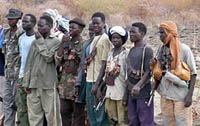Darfur – the place the world has forgotten
Slow as it was to pick up the Darfur story, the international media has been quick to drop it. After all, a new pariah state has been found, a new whipping boy, a new demonology is being formed, around Iran.

Yet how many people are being systematically murdered in Iran? How many people has the Iranian government slaughtered? How many worries do the UN humanitarian agencies have about the Iranians? How many prisoners has the Iranian government tortured? How many people are held in concentration camps? Is there an Iranian version of Lynndie England? Do the Iranians wire prisoners’ genitals up with electrodes, urinate in their food or force them to commit sodomy or other acts of sexual depravity?
No, or none are the answers to these questions. Not so in Darfur, from which the international media circus has moved on (the story got its two-week rise, its one-week climax and its two-week decline), yet the suffering has not.
Since fighting began in Darfur, western Sudan, two years ago after the Sudanese Liberation Movement/Army (SLM/A) and Justice and Equality Movement (JEM) rebels attacked government troops, over two million people have been displaced and many thousands killed. Villages have been burned and pillaged, women raped and/or forced into sexual slavery, children made orphans.
The Sudanese government admits having armed Self-Defense Groups against the rebels but denies having anything to do with the Janjaweed – yet it is these Arabic nomads who ride into the villages of the Fur people (Negroes) on camel or horseback to pillage what is left after air raids by government jets.
Since January, 300 people have been murdered by the Janjaweed, who have managed to destabilise the entire region, riding across to the border to attack the refugees in camps inside neighbouring Chad and putting the lives of the refugees at risk of starvation or death by disease.
The United Nations Organization reported at the end of last week that the violence continues, that up to 125 displaced persons per day continue to pour into the camps and that the region is “increasingly volatile”, while Kofi Annan, according to his spokesperson, has “expressed his concern about continuing insecurity and the increasing number of direct threats to relief workers. ”
Access to those in need is becoming more difficult, making their situation all the more vulnerable and the growing instability has led to an increasingly complex situation in which refugees are fleeing in both directions – out of Darfur and into Chad, or out of Chad and back to Darfur when their refugee camps are attacked.
And the world sits idly by, terrified by Teheran just because Iran claims its right to pursue a pacific nuclear programme, while Israel sits on 100 nuclear missiles.
Timothy BANCROFT-HINCHEY
Subscribe to Pravda.Ru Telegram channel, Facebook, RSS!


